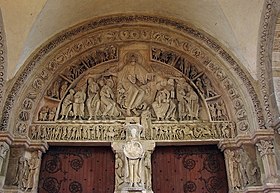
Back طبلة (عمارة) Arabic Тымпан Byelorussian Тымпан BE-X-OLD Тимпан (архитектура) Bulgarian Timpà (arquitectura) Catalan Tympanon Czech Tympanon Danish Tympanon (Architektur) German Τύμπανο (αρχιτεκτονική) Greek Timpano (arkitekturo) Esperanto

A tympanum (pl.: tympana; from Greek and Latin words meaning "drum") is the semi-circular or triangular decorative wall surface over an entrance, door or window, which is bounded by a lintel and an arch.[1] It often contains pedimental sculpture or other imagery or ornaments.[2] Many architectural styles include this element, although it is most commonly associated with Romanesque and Gothic architecture.[3]
Alternatively, the tympanum may hold an inscription, or in modern times, a clock face.
- ^ "Glossary - Tympanum". Architecture of the Indian Subcontinent. Archived from the original on 2012-03-06. Retrieved 2007-06-28.
- ^ "Glossary of Medieval Art and Architecture - tympanum". University of Pittsburgh. Archived from the original on 2018-01-16. Retrieved 2007-06-23.
- ^ "Illustrated Architecture Dictionary - Tympanum". www.buffaloah.com. Archived from the original on 2014-06-22. Retrieved 2014-04-12.